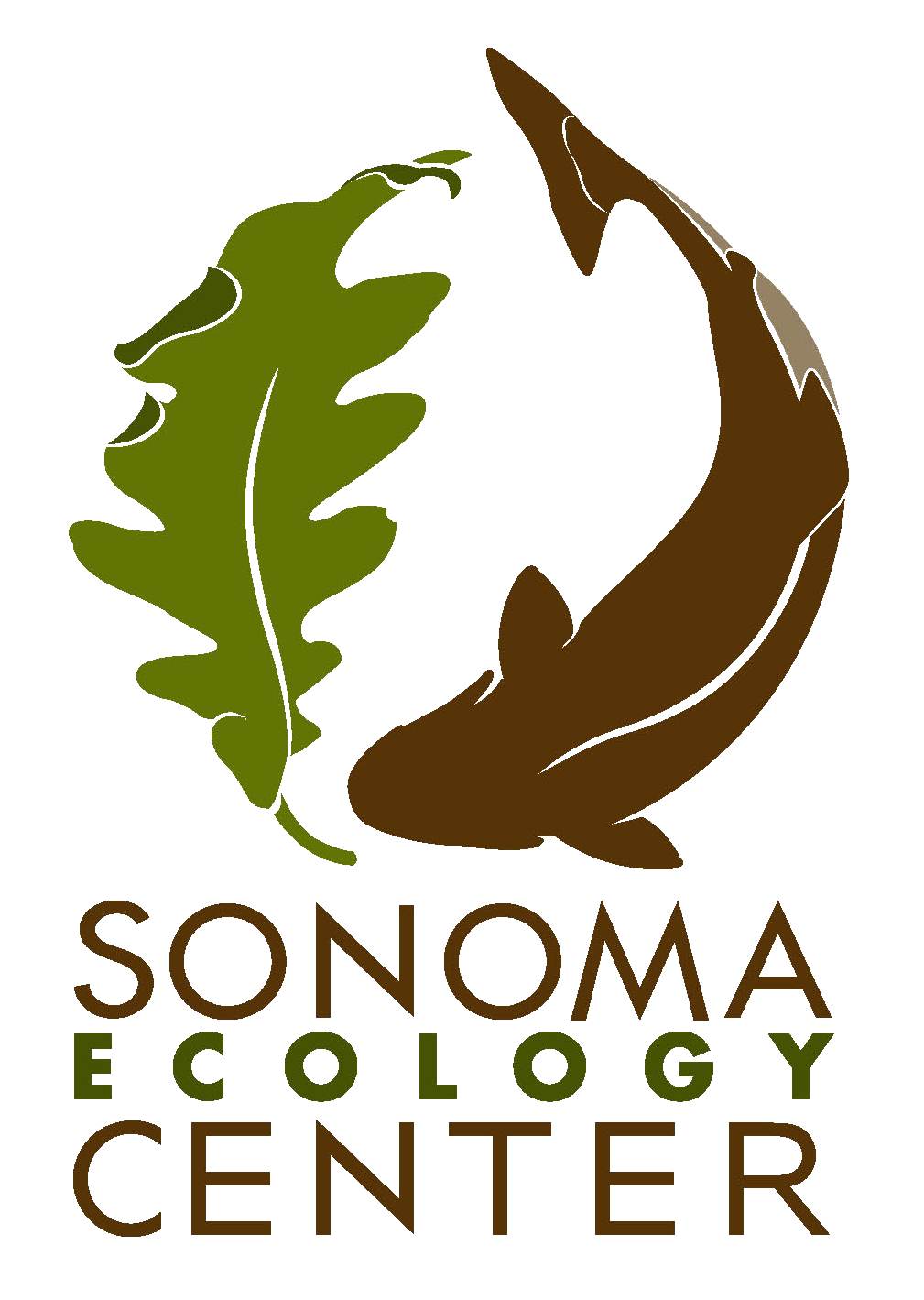[Español abajo]
Hikers traversing our Creekside Nature Trail can enjoy views of a beautiful cherry plum tree that bursts into a beautiful bloom of pink flowers in spring, a panoramic view of Sugarloaf Ridge, and Hood Mountain to the West. As the name suggests, the trail passes by the calming Sonoma Creek next to our campgrounds. What many hikers might not know is that our 0.9-mile Creekside Nature Trail was built to be ADA-accessible. The start and end of the trail — from the main day-use parking lot to the White Barn — both have van-accessible ADA parking and accessible restrooms.
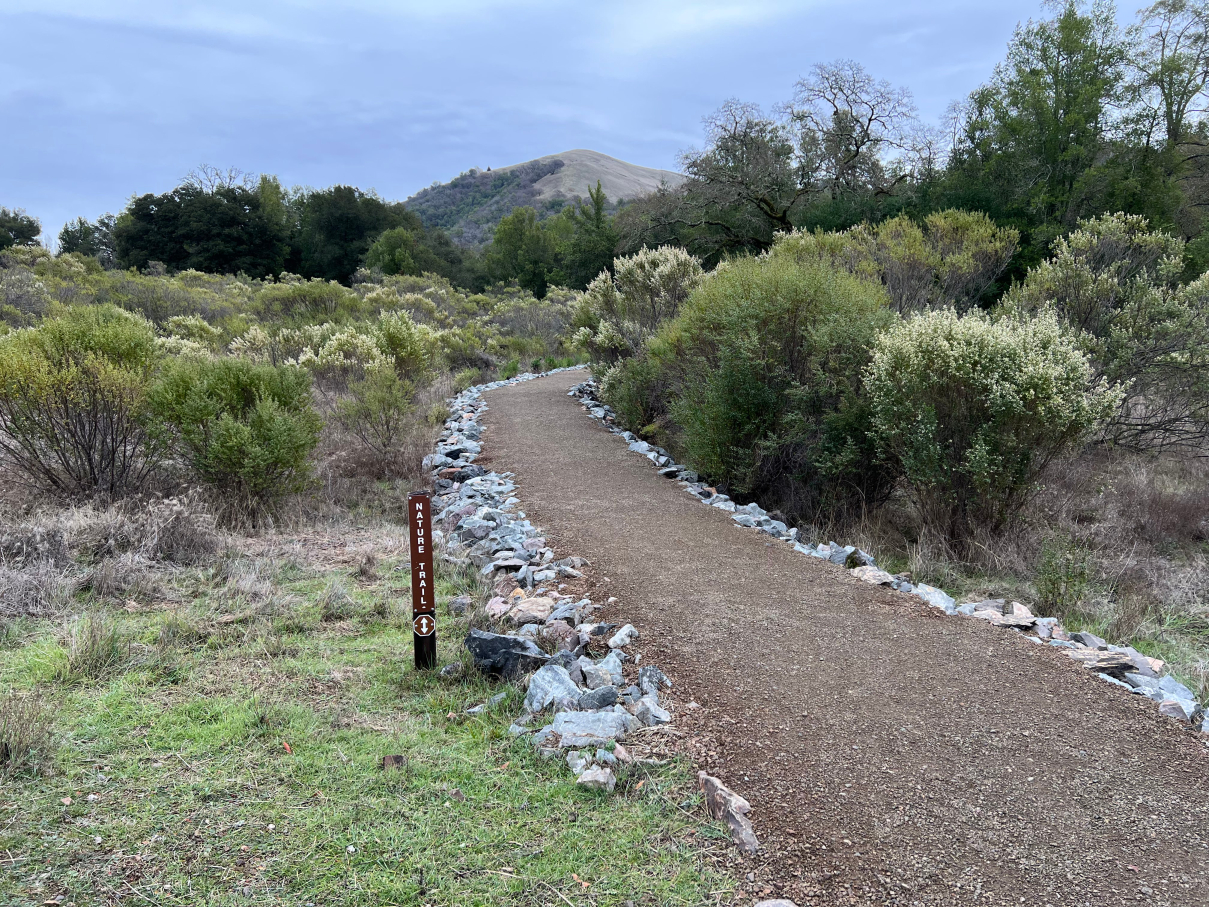
Our 0.9-mile Creekside Nature Trail was built to be ADA-compliant. This amazing trail was built by California State Parks and completed in 2017.
Last year, we were awarded Park Partner of the Year at the California League of Park Associations (CALPA) conference in recognition of our innovative and inclusive programming, particularly our Limited Mobility events and our Senderos Naturales Spanish Language events.
These successes notwithstanding, the community at Sugarloaf, which comprises of Sonoma Ecology Center staff, volunteers, and visitors understands that there is more to be done to make Sugarloaf a place that truly serves the diverse needs of those who frequent our park.
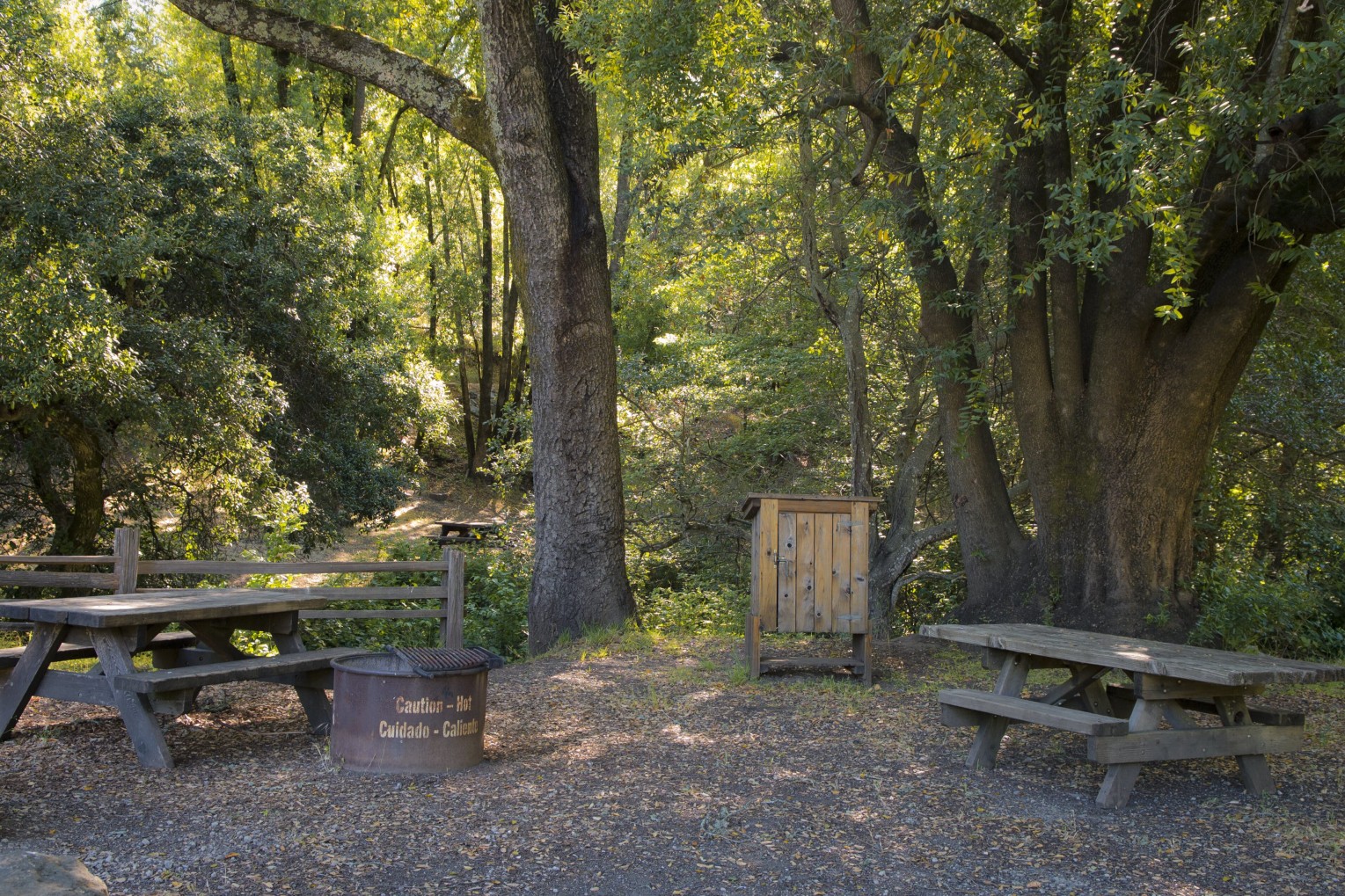
Campsite 6, one of our two wheelchair-accessible campsites. Wheelchair users who wish to camp at Sugarloaf may do so at our 2 wheelchair-accessible campsites, with accessible restrooms, showers, campfire pits, and a variety of wheelchair seating areas. Campers can book day-of or reserve campsites in advance through reservecalifornia.com.
Ongoing efforts to make Sugarloaf more accessible have been a collaborative endeavor between Sugarloaf staff and the community we serve. Judith Smith, a former UC California Naturalist student who uses a power wheelchair, fell in love with Sugarloaf after visiting the park during class field trips. She wanted to find ways to make the park more accessible for people who use wheelchairs. Together with Bonnie Lewkowicz, Founder and Director of Access Northern California and long-time disability rights advocate, they offered suggestions to Sugarloaf staff on how to improve the accessibility of the park.
“A lot of what we suggested were things that the park can implement relatively quickly,” says Bonnie, who also uses a power wheelchair. Replicating signage of each trail’s average slope and trail width, such as what’s currently available for the Creekside Nature trail, gives each visitor more information on whether they should attempt the trail, according to Bonnie. Other recommendations by Judy and Bonnie include making sure that volunteers who work at the kiosk know the best paths for those with limited mobility to get from place to place in the park and smoothing the ground surfaces of certain areas.
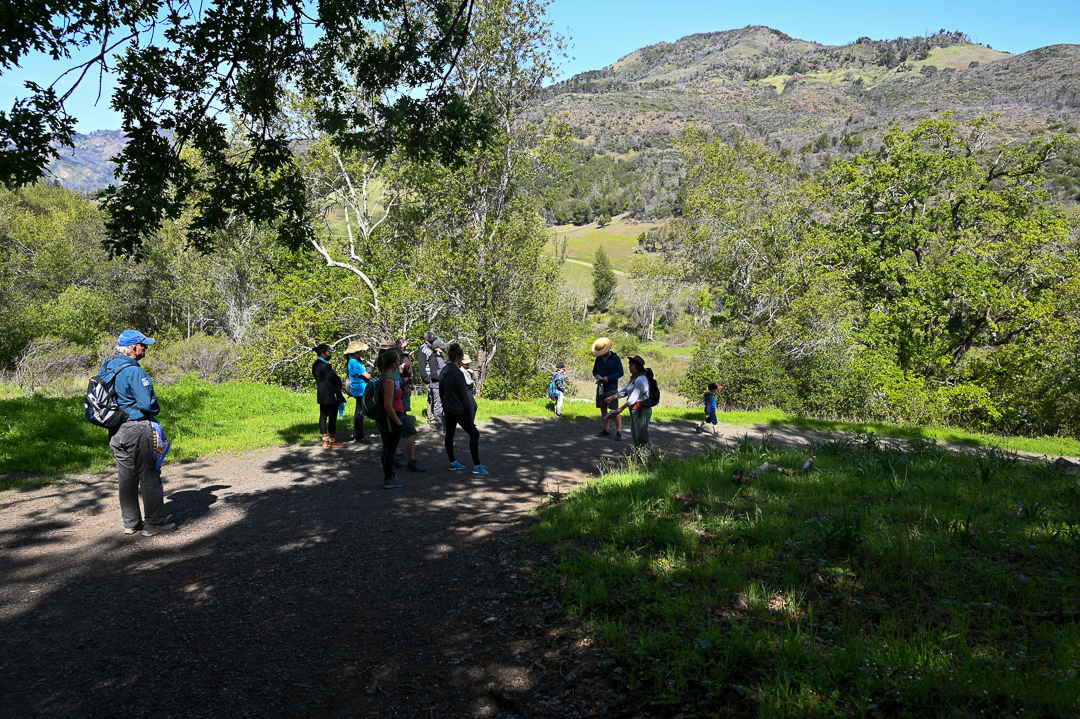
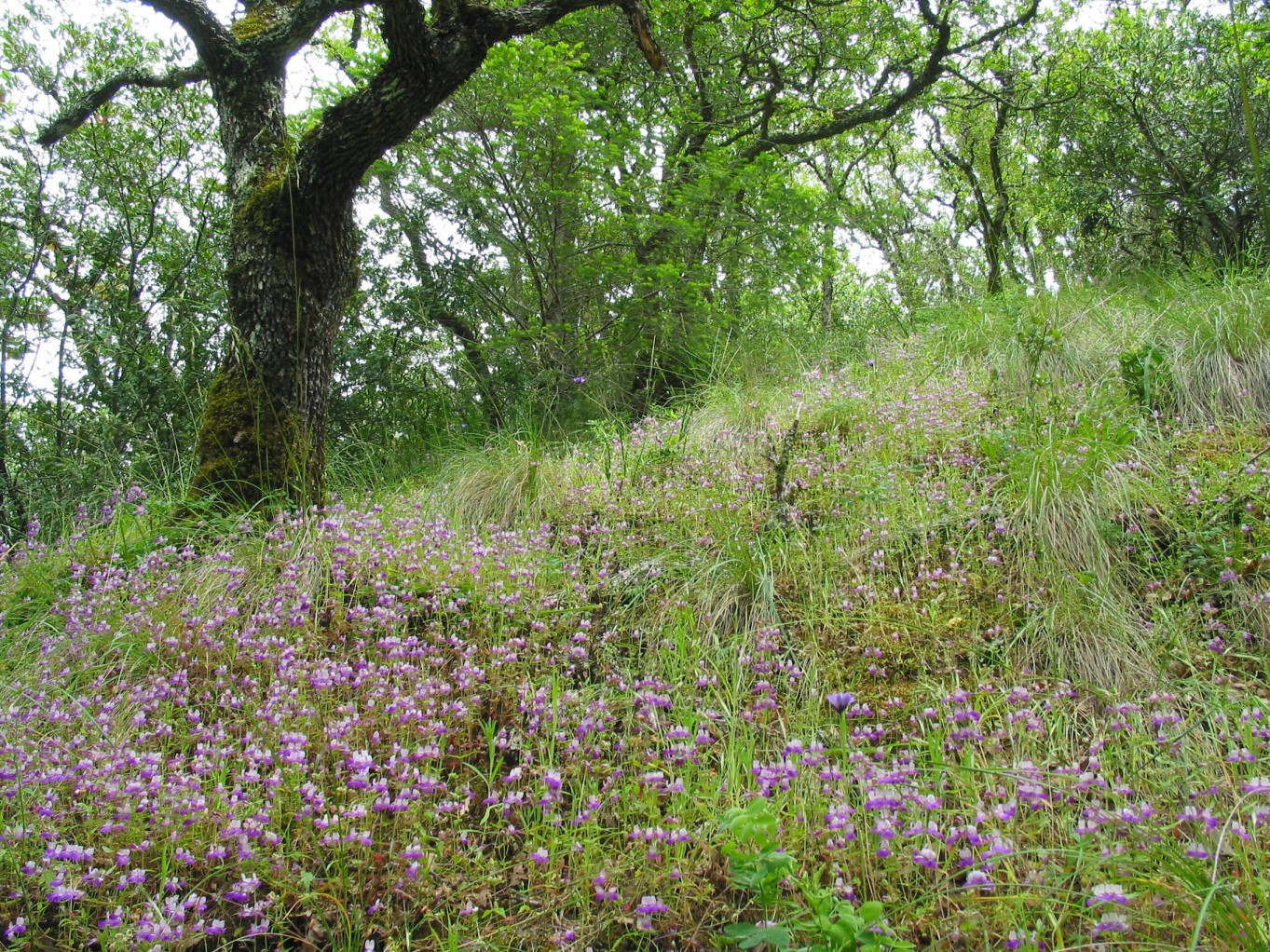
Left: Hikers standing on Hillside trail. You can see Meadow trail in the background, center. Right: The Meadow-Hillside Loop is a 2-mile hike that starts at the Robert Ferguson Observatory.
“I grew up in the mountains. I love trails that are accidentally accessible, and Sugarloaf is full of trails like these. Bonnie and I hiked the Hillside trail all the way up until it goes into a steeper vein. There are other ways to explore sugarloaf that are not through the ADA trail,” says Judy.
Our Meadow Trail, while not considered an ADA trail, is mostly gravel-free and is often passable by those who use wheelchairs for approximately 0.75 mile. This hike can be accessed through the White Barn parking lot and the Robert Ferguson Observatory.
Making transportation up to the park for people with limited mobility in the first place remains a challenge. “Transportation is a tricky one. It’s an expensive one. Probably one of the biggest barriers to disabled people being able to participate. It’s not an easy, quick fix,” says Judy. Even so, Bonnie is optimistic about the efforts that are currently underway. “I’d say that the biggest asset the park has is the willingness to look at this issue and make changes,” says Bonnie.
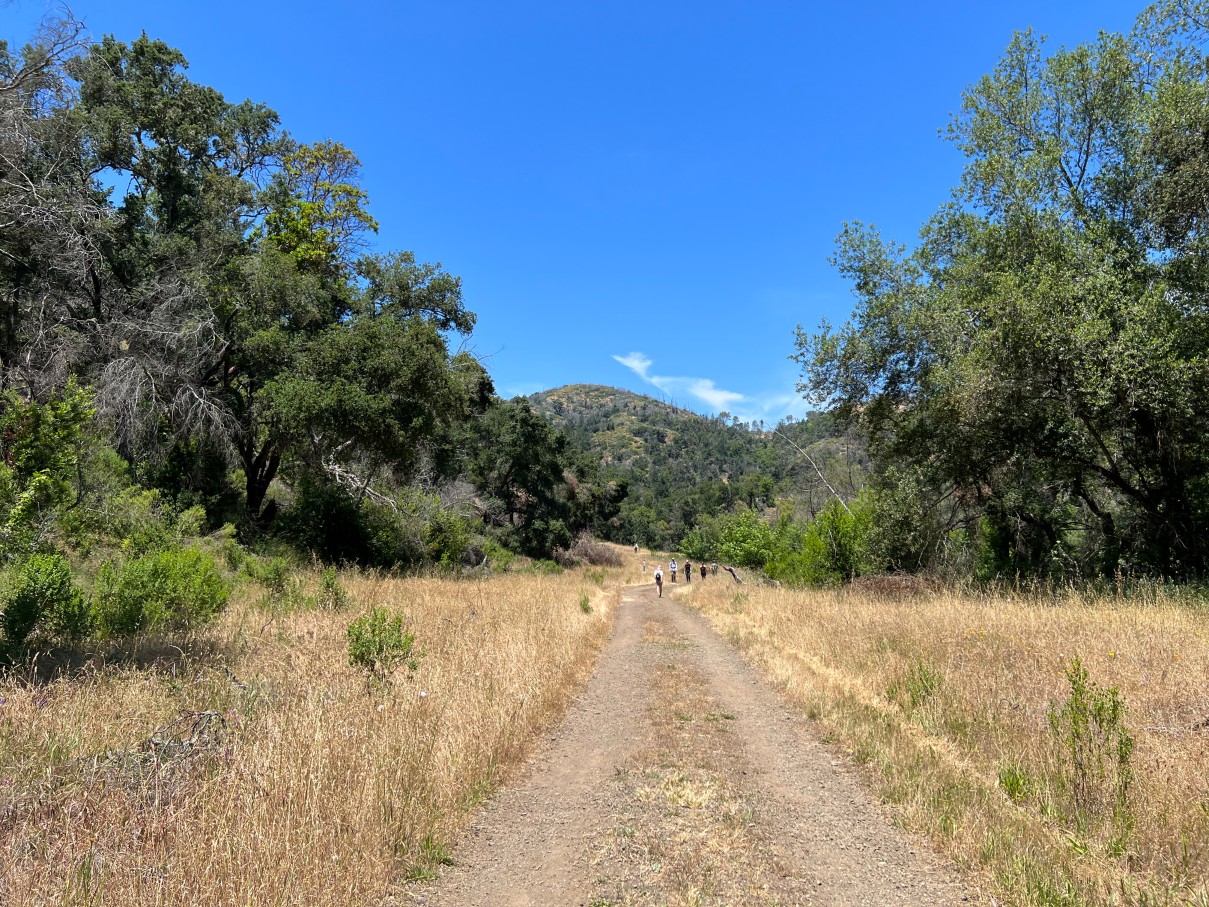
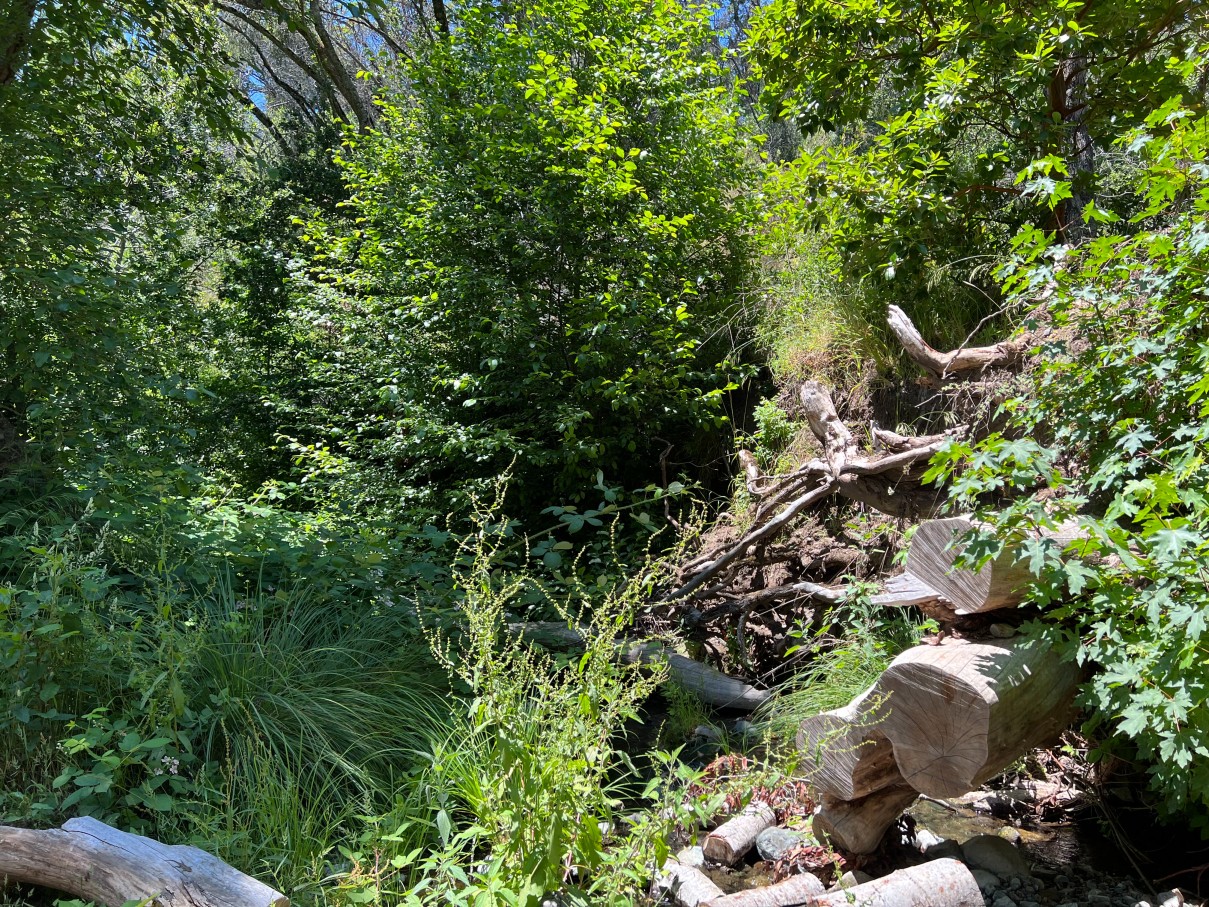
Views from upper Meadow Trail. The trailhead of Meadow trail is to the east of Robert Ferguson Observatory and extends 0.8 miles to its junction with Brushy Peaks and Hillside. Although not technically ADA-compliant, people who use wheelchairs can traverse the entirety of the trail during the dry season, when the compacted soil surface is not oversaturated.
Using a grant from the National Environmental Education Foundation, Sugarloaf staff are working with Judy and Bonnie to assess the conditions of the park and create a plan on how we can make the park more accessible for hikers with limited mobility.
Dr. Dan Levitis, our resident Ph.D. biologist and zoologist, who plays a leading role in pushing ahead accessibility projects at Sugarloaf is appreciative of the feedback we are getting from the community. “The disability community has told us clearly that they want more information available on the park’s trails and facilities so that each person can make their own informed decisions about where in the park to go. We have the ADA-compliant Creekside trail, which is great, but that doesn’t mean the rest of the park is closed to people with access challenges,” Dr. Levitis says. On each hiking event listed on Sugarloaf’s website, we have started adding an “Ease of Access” note that describes how steep and wheelchair-accessible the trail is so that attendees can decide for themselves whether they would like to participate.
“I am working with Jack Hines on a spreadsheet on the length, steepness, surface, etc. of every trail, along with a description of each trail and numbers on the total climb. We are working to make as much detailed information as possible widely available, and to listen to the community about what small changes we might be able to make that could make a big difference in inclusion,” continues Dr. Levitis.
We are also currently implementing a project to make the Community Science office, including making the door to the office wider and adding a flatter ramp to make it easier for wheelchair users to enter. Bruce Hall, our long-time maintenance staffer, has drawn up a plan for this project and we are now only awaiting approval from California State Parks. We are also reorganizing the displays and shelves in the Visitor Center to make it as easy as possible for those with mobility challenges to navigate.
While these efforts are underway, the Sugarloaf volunteers are making our current infrastructure available to more people. This often means more tailored programming and communications.
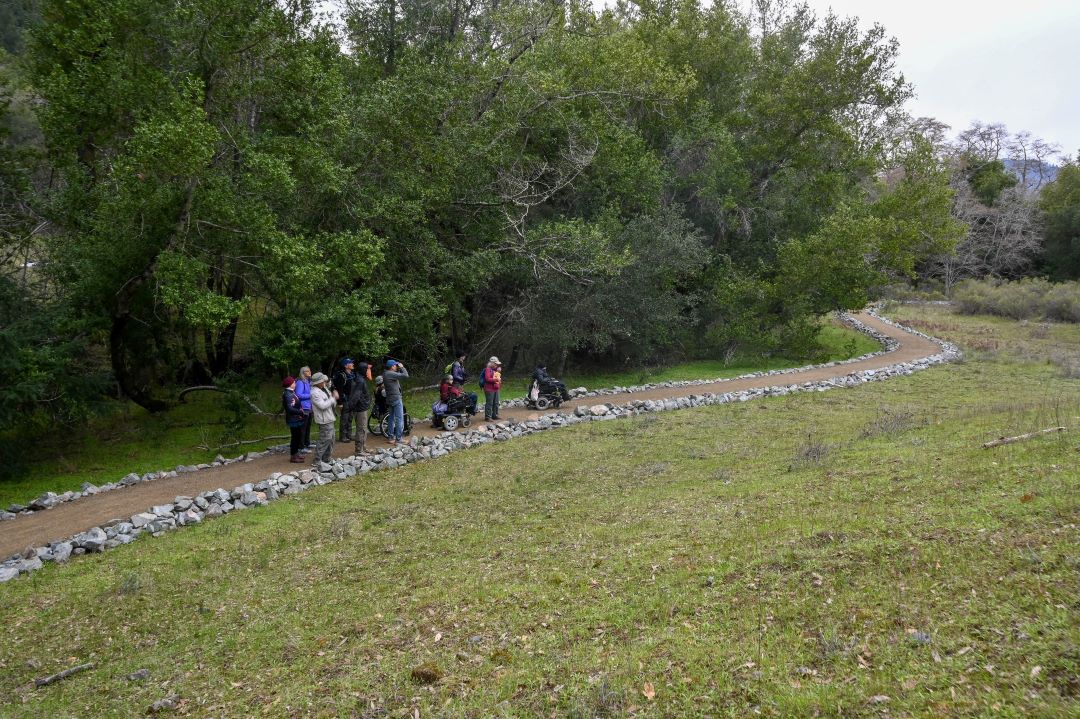
Hikers participating in a Limited Mobility Dusk Birding event at Creekside Nature Trail.
Judy Armstrong, a former student of SEC’s California Naturalist course who came to Sugarloaf on field trips, came up with the idea of leading Slow Journeys, a series of interactive outings that are suitable for participants who use strollers, walkers, wheelchairs, canes. The first outing took place at Sugarloaf’s campground loop with less than 5 degrees slope, and participants got the chance to taste a Douglas Fir needle and California Laurel leaf and take frequent 5-10 minutes of breaks to participate in bird watching, learning about nature and enjoying being outdoors.
“What’s extra special about Sugarloaf is that the park’s accessible trails (Meadow and Creekside Nature Trail) run through beautiful, wild spots that are full of biodiversity. The Limited-Mobility Bird Walks, Hikes, and the Slow Journeys can give people time to enjoy nature at a slower pace in a group setting, with no pressure,” says Judy Armstrong.
With future funding, designing a more comprehensive plan on how we can make this park more accessible to those of diverse needs can become more of a reality, “While our partners at State Parks are fully supportive of efforts to make Sugarloaf more accessible, there is required planning and permitting that is quite expensive. Making significant changes to the park’s trail network for accessibility reasons would require having a new, approved trails plan that would require several years and cost at least $100,000. Also, with additional funding, we would be so excited to work with consultants and artists to develop auditory and tactile interpretive materials, which is not covered under our current grant,” says Dr. Dan Levitis.
Visitantes navegando nuestro sendero Creekside Nature pueden disfrutar vistas de un bello ciruelo con bellas flores rosas durante la primavera, una vista panorámica de Sugarloaf Ridge, y de Hood Mountain al oeste. Como el nombre lo sugiere, el sendero es adyacente al Arroyo de Sonoma, junto a nuestra área de acampar. Lo que muchos visitantes tal vez no sepan es que este sendero de 0.9 millas fue construido para cumplir con la Ley de Estadounidenses con Discapacidades (ADA, por sus siglas en inglés). Ambas entradas al sendero–ya sea del lado del estacionamiento principal o del Granero Blanco– cuentan con estacionamiento accesible designado para camionetas.

Nuestro sendero Creekside Nature fue construido para cumplir con la Ley ADA.
El año pasado fuimos otorgados el premio de “Socio de parques del año” en la conferencia de California League of Park Associations (CALPA) en reconocimiento por nuestros programas innovativos e inclusivos, particularmente nuestros eventos para personas con límites de movilidad y nuestro programa para hispanohablantes, Senderos Naturales. La instalación del sendero Creekside Nature es un ejemplo de esos esfuerzos.
A pesar de estos éxitos, la comunidad en Sugarloaf, la cual incluye empleados, voluntarios, y visitantes, comprende que hay mucho más que hacer para que Sugarloaf realmente sea un lugar que cumple las diversas necesidades de todos quienes visitan nuestro parque.

El sitio #6, uno de nuestros sitios de acampar accesibles. Personas que usan silla de ruedas y quieran acampar en Sugarloaf pueden pedir ser acomodados en uno de nuestros dos sitios accesibles, cerca de los baños y regaderas, los cuales son igualmente accesibles. Interesados en acampar pueden reservar sitios de acampar en reservecalifornia.com.
Iniciativas para hacer a Sugarloaf más accesible han sido un esfuerzo colaborativo entre empleados de Sonoma Ecology Center en Sugarloaf y la comunidad a la que servimos. Judith Smith, una participante del programa UC California Naturalis quien usa una silla de ruedas motorizada, se enamoró de Sugarloaf después de visitar el parque como componente de la clase. Ella quiso encontrar maneras de hacer el parque más accesible para personas que usan sillas de ruedas. Junto con Bonnie Lewkowicz, fundadora y directora de Access Northern California y defensora de derechos de personas con discapacidades por muchos años, ofrecieron sugerencias a los empleados acerca de cómo mejorar la accesibilidad del parque.
“Mucho de lo que hemos sugerido son cosas que el parque puede implementar relativamente pronto,” dice Lewkowicz, quien también usa una silla de ruedas motorizada. Replicar los letreros de cada sendero con su inclinación y anchura, como el que actualmente existe al comienzo del sendero Creekside Nature, ayuda al visitante a decidir si pueden recorrer el sendero, de acuerdo a Lewkowicz. Otras recomendaciones de Smith y Lewkowicz incluyen que los voluntarios en el quiosco sepan cual es la mejor manera de navegar el parque para aquellos con movilidad reducida y alisar la superficie de ciertas áreas.


Izquierda: visitantes en el sendero Hillside. En el fondo, al centro, se puede ver el sendero Meadow. Derecha: El circuito Meadow-Hillside es una caminata de dos millas que comienza junto al Observatorio Robert Ferguson.
“Crecí en las montañas. Amo senderos que son accidentalmente accesibles, y Sugarloaf está lleno de senderos como este [ejemplo]. Bonnie y yo recorrimos el sendero Hillside hasta llegar a una sección muy inclinada. Hay otras maneras de explorar Sugarloaf que no son solamente el sendero designado como accesible,” dice Smith.
El sendero Meadow, aunque formalmente no considerado un sendero que cumple con las reglas de la ley ADA, es, por la mayor parte, una superficie sin grava y por la mayor parte navegable para personas que utilizan sillas de ruedas por al menos ¾ de una milla. Este sendero se encuentra junto al Observatorio Robert Ferguson.
La transportación es difícil. Es costosa. Probablemente una de la barreras más grandes a la participación para personas con discapacidades. No hay una solución rápida o fácil,” dice Smith. Aún así, Lewkowicz es optimista acerca de los esfuerzos que van a tomar lugar. “Diría que el valor más grande que tiene el parque es la voluntad de ver este problema y hacer cambios.”


El comienzo del sendero Meadow se ubica al Este del Observatorio Robert Ferguson y se extiende aproximadamente 0.8 millas a la conexión con los senderos Brushy Peaks y Hillside. Aunque técnicamente no es un sendero que cumple con la ley ADA, personas en sillas de ruedas pueden recorrer este sendero durante la temporada seca, cuando la superficie del camino no está sobresaturado.
Mediante una beca de parte de National Environmental Education Foundation, empleados de Sonoma Ecology Center en Sugarloaf trabajan con Smith y Lewkowicz para evaluar condiciones en el parque y crear un plan para decidir cómo podemos hacer el parque más accesible para visitantes con movilidad reducida.
El Doctor Dan Levitis, nuestro biólogo y zoólogo residente, quien desempeña un papel principal en abogar por proyectos de accesibilidad en Sugarloaf aprecia los comentarios que hemos recibido de la comunidad. “La comunidad de personas con discapacidades nos ha dicho claramente que quieren más información disponible de los senderos del parque y las instalaciones para que cada persona pueda tomar una propia decisión informada acerca de dónde ir en el parque. Tenemos el sendero Creekside Nature, el cual cumple con la ley ADA, y es genial, pero eso no significa que el resto del parque está cerrado a personas con barreras de acceso,” dice Levitis. En cada página con información acerca de un evento público, empezamos a añadir la una nota con la “facilidad de acceso” para cada evento, la cuál describe que tan inclinado y accesible el sendero es para personas en sillas de ruedas para que cada persona que planea asistir al evento pueda decidir por ellos mismos si les gustaría participar.
“Estoy trabajando con Jack Hines en una hoja de cálculo que contiene lo largo que es un sendero, su inclinación, de qué consiste su superficie, junto con una descripción de cada sendero y la cantidad de ascenso total. Estamos trabajando para tener disponible información detallada lo tanto posible y lo más posiblemente disponible, y escuchar a la comunidad acerca de cuáles pequeños cambios podemos hacer que harían un gran impacto en inclusión,” continúa Levitis.
Al mismo tiempo, estamos implementando un proyecto en nuestra oficina de ciencia comunitaria, incluyendo ampliar la puerta a la oficina y añadir una rampa más plana para que personas en sillas de ruedas puedan entrar. Bruce Hall, nuestro empleado de mantenimiento desde hace muchos años, ha dibujado un plan para este proyecto y ahora solo esperamos autorización de parte de Parques Estatales de California [para empezar el proyecto]. También organizamos los estantes y exhibiciones dentro del Centro de visitantes para hacerlo más navegable para personas con movilidad reducida.
Mientras estos esfuerzos van en marcha, voluntarios en Sugarloaf están haciendo nuestra infraestructura actual disponible a más gente. Esto significa comunicaciones y programas más especializados.

Visitantes participan en “Limited Mobility Dusk Birding” en el sendero Creekside Nature Trail.
Judy Armstrong, una antigua participante en el programa California Naturalist ofrecido por Sonoma Ecology Center, ideó “Slow Journeys”, una serie de salidas interactivas adecuadas para participantes que usan sillas de ruedas, andadores, bastón, o personas con carriola o que de otra manera viven con movilidad reducida. Teniendo lugar en el área de acampar de Sugarloaf, participantes tendrán la oportunidad de saborear agujas del abeto de Douglas y Laurel californiano y tomar descansos frecuentes de 5 a 10 minutos para participar en fotografía, bosquejo para niños, observación de aves, o de usar un diario de campo.
“Lo que es extra especial acerca de Sugarloaf es que los senderos accesibles del parque (Meadow, Creekside Nature) es que atraviesan bellos lugares salvajes llenos de biodiversidad. Las caminatas de observación de aves para personas con movilidad reducida, y “Slow Journeys” pueden dar a la gente tiempo para disfrutar la naturaleza a un paso lento en grupo, sin apuro,” dice Armstrong.
Con financiación futura, el diseñar un plan más comprensivo en el cual podemos hacer este parque más accesible a aquellos con diversas necesidades puede convertirse en realidad. “Mientras nuestros socios en Parques Estatales apoyan completamente nuestros esfuerzos para hacer a Sugarloaf más accesible, se requiere planear y obtener permisos que son muy costosos. El hacer cambios significantes a la red de senderos del parque por razones de accesibilidad requeriría aprobación de un nuevo plan aprobado y sometido para revisión geológica y cumplimiento de la Ley de Calidad Ambiental de California (CEQA, por sus siglas en inglés), lo cual puede costar al menos $100,000. Con financiación futura, estaríamos muy emocionados de trabajar con asesores y artistas para desarrollar materiales de interpretación auditorio y táctil, lo cual actualmente no está cubierto en nuestra beca,” dice Levitis.
